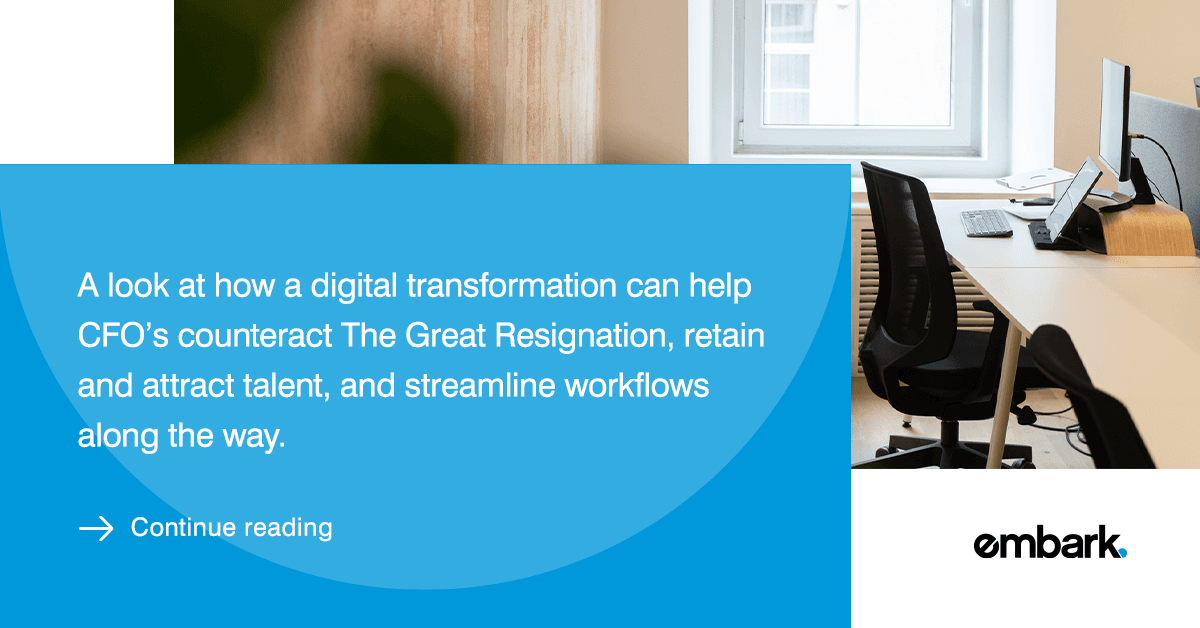
If you're struggling to retain and hire talent right now, you're not alone. To put it mildly, The Great Resignation, along with the dynamics fueling it, have some serious teeth. But since throwing up your hands and calling it a day isn't an option – assuming you want your business to succeed – then perhaps it's time to look at the issue from a different angle.
Granted, we're not recruiting or employee engagement specialists here at Embark. However, we definitely know our way around digital transformations, and it's that crucial intersection of people, places, and technology that can make your finance organization leaner and meaner, all while helping you retain and attract top talent. We'll explain.
The Heart of the Problem for CFOs
There's never enough time. You'll always have a month-end close lurking around the corner, a new initiative waiting in the wings, and financial reports that aren't going to complete themselves. Time and people – it seems like your finance organization is always clamoring for more, making today's climate especially challenging.
So what happens when you're struggling to fill open seats? And keep occupied seats filled? As you know all too well, time and people are the rarest of resources these days. And no matter what you've tried – signing and retention bonuses, perks galore, enhanced benefits – nothing seems to work.
But that's the heart of the problem for today's companies, relying on traditional tactics to solve a patently untraditional issue. While money certainly never hurts, the current labor market isn't something you can throw wads of cash at and expect the best and the brightest to shake loose. Nor is money enough to keep your best people engaged and, ultimately, an employee of your organization.
Digital Transformation to the Rescue
Rather than reacting like everyone else, though, what if you took another approach? One that utilizes all of the different tools and insights available to you? That's what digital transformation really is – the essential convergence of people, processes, and technology that streamlines your finance organization and generates actionable business intelligence.
Now, you're probably wondering what all of this has to do with your ability to retain and recruit. Well, in a word – plenty. Because as handy as Microsoft Excel is, there's an excellent chance you're using it far beyond its natural capabilities. Put another way, you're bringing a spork to your finance organization's knife fight.
Don't get us wrong, a spork has its time and place, as does Excel. But when you push that old workhorse past what it's designed to do, mountains of manual processes are the likely result. However, what if you use appropriate tools, automate those tedious manual processes, and transform your data throughput from a disjointed stream to an efficient, fast-running river?
By implementing the right tools for the right jobs, upskilling your people to use these tools, and improving your processes to establish guide rails, you're working faster and more accurately. Or, to revisit a theme, you're saving time and becoming more productive with fewer people on the front lines.
Happier, Engaged People
That's not to say automation and data analytics are a substitute for your people. Far from it. However, digital transformation allows your people to learn, grow, and innovate rather than being data jockeys that shuffle numbers from system to system, over and over again.
Think of it like the workers on a car manufacturer's automated assembly line. Of course, people are still essential to the entire process, they're just not the ones ratcheting a 7/16 bolt behind a front quarter panel anymore. Instead, they're leading the robotic charge, utilizing the technology, and keeping everything running smoothly.
The same occurs with your people after a digital transformation – they're suddenly helping you solve complex problems, innovating, and using their knowledge and skill to help guide the ship. Just as importantly, you’re creating and expanding a data culture along the way, one that's more challenging and fulfilling for your people.
Ultimately, a digital transformation helps you react to today's topsy-turvy labor market in two distinct ways:
- Streamlining your operations so you can do less with more
- Enhancing the employee experience by improving engagement and job satisfaction levels
Once all is said and done, you're left with motivated people that wouldn't dream of leaving your organization, not to mention an extremely attractive work environment and culture for cream of the crop candidates.
Understanding How a Transformation Propels You
Granted, we've spent the last few hundred words describing the benefits of a transformation at a pretty high level. And while everything we said is both appropriate and accurate, it doesn't do much for helping you fill in the blanks or see how a digital transformation looks in the real world.
Therefore, we want to discuss how a typical finance organization operates, where its inefficiencies stem from, and why a transformation initiative is just the salve to cure those ills. And we want to start with how you're likely layering your financial technologies.
The Three Layers of Financial Technologies
Take a look at the following graphic and see if anything peculiar sticks out to you:
That big question mark in the middle layer of the pyramid seems a bit odd, right? Unfortunately, that's how the technology base looks in most finance organizations.
In the bottom layer, you have your Excel spreadsheets and other tools you use for manual, repetitive, but essential tasks. The top layer usually consists of automated systems like your ERP, functionally the polar opposite of the bottom layer.
But the problem is really in the middle, where that pesky question resides. And it’s problematic because most businesses try to fill that void with people. However, simply expanding your headcount isn't a very efficient approach since people:
- Are hard to come by these days
- Don't want to be stuck in repetitive, manual, mind-numbing tasks
- Come at a high cost
So how do you bridge that chasm between those essential tools on the bottom layer and critical systems up top if people aren't the answer? That's where technology plays such an instrumental role, providing you with automated, scalable solutions that link your systems and sources to your indispensable spreadsheets, small databases, and task-specific tools.
Once again, since your people are no longer schlepping numbers between these top and bottom layers, it allows them to grow, learn, and challenge themselves. The result – highly efficient accounting and finance functions that generate genuine business intelligence at every turn, filled with smiling, content faces that would rather wrestle a Kodiak bear than leave your organization.
A Closer Look at Your Middle Layer
At this point, we've hopefully convinced you that throwing money and people at the problems plaguing today's marketplace isn't your best route. With that established, now let's take a closer look at what a far more efficient and effective middle layer would look like in your finance organization.
A transformation initiative bridges your data sources – the top level of your financial technology pyramid – to the many different endpoints without having your people shoulder those repetitive tasks. Instead, business information automatically flows into:
- Purpose-built solutions for things like budgeting and forecasting
- Data dashboards to provide leadership with agile, in-depth, real-time reports
- Excel workbooks
In the meantime, your people spend their time creating new value for your business by flexing the very knowledge and skill they thought they would be using for their job in the first place.
The Bottom Line
You’re not imagining or exaggerating your labor problems right now. We're sure you've seen the scary statistics, talking about the millions of people voluntarily leaving their jobs every month and employers' desperate struggle to find and hire talent.
But as we've discussed, one of the most viable, impactful solutions available to CFOs is getting very little attention – the digital transformation. Thus, our advice is to start small and seek quick and easy wins rather than trying to overhaul your entire finance organization with one fell swoop.








